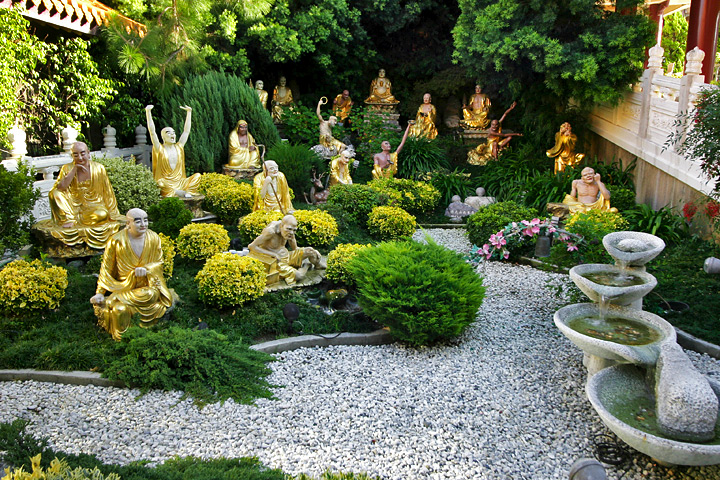|
Buddhist Temples In Korea
Buddhist temples are an important part of the Korean landscape. Most Korean temples have names ending in ''-sa'' (), which means "monastery" in Sino-Korean vocabulary, Sino-Korean. Many temples participate in the Templestay program, where visitors can experience Buddhist culture and even stay at the temple overnight. Background A distinctive form of Buddhism evolved in Korea. This was facilitated by the geographical location and cultural conditions. Buddhism first arrived in Korea in 372 in Goguryeo. In 374 the influential Han Chinese monk Ado arrived in the kingdom and inspired King Sosurim of Goguryeo the following year. The first two temples Seongmunsa and Ilbullansa were built in 375 on the order of the king. Buddhism soon became the national religion of Goguryeo. With the advent of Taoism in 624 the rulers began to suppress Buddhism and its importance quickly declined. The Baekje Kingdom, on the other hand, flourished under the influence of Buddhism. In 552 Buddhist scriptu ... [...More Info...] [...Related Items...] OR: [Wikipedia] [Google] [Baidu] |
Sino-Korean Vocabulary
Sino-Korean vocabulary or Hanja-eo () refers to Korean words of Chinese origin. Sino-Korean vocabulary includes words borrowed directly from Chinese, as well as new Korean words created from Chinese characters, and words borrowed from Sino-Japanese vocabulary. Many of these terms were borrowed during the height of Chinese-language literature on Korean culture. Subsequently, many of these words have also been truncated or altered for the Korean language. Estimates of the percentage of Sino-Korean ranges from as low as 30% to as high as 70%. According to the '' Standard Korean Language Dictionary'' published by the National Institute of Korean Language (NIKL), Sino-Korean represents approximately 57% of the Korean vocabulary. History The use of Chinese and Chinese characters in Korea dates back to at least 194 BCE. While Sino-Korean words were widely used during the Three Kingdoms period, they became even more popular during the Silla period. During this time, male aristocrat ... [...More Info...] [...Related Items...] OR: [Wikipedia] [Google] [Baidu] |
Dharma
Dharma (; , ) is a key concept in various Indian religions. The term ''dharma'' does not have a single, clear Untranslatability, translation and conveys a multifaceted idea. Etymologically, it comes from the Sanskrit ''dhr-'', meaning ''to hold'' or ''to support'', thus referring to law that sustains things—from one's life to society, and to the Universe at large. In its most commonly used sense, dharma refers to an individual's moral responsibilities or duties; the dharma of a farmer differs from the dharma of a soldier, thus making the concept of dharma a varying dynamic. As with the other components of the Puruṣārtha, the concept of ''dharma'' is pan-Indian. The antonym of dharma is ''adharma''. In Hinduism, ''dharma'' denotes behaviour that is considered to be in accord with ''Ṛta''—the "order and custom" that makes life and universe possible. This includes duties, rights, laws, conduct, virtues and "right way of living" according to the stage of life or social posi ... [...More Info...] [...Related Items...] OR: [Wikipedia] [Google] [Baidu] |
Guinsa
Guinsa (), in the Yeonhwa area of the Sobaek Mountains located near Danyang County, Danyang in Chungcheongbuk-do, South Korea, is the headquarters of the Cheontae school of Buddhism in Korea, Korean Buddhism. Guinsa is the administrative center of over 140 sub-temples and hermitages of the Cheontae sect. Although the architecture of Guinsa follows that of many other Buddhist temples in Korea, it is also markedly different in that the structures are several stories tall, instead of the typical one or two stories that structures in many other Korean temples have. This may be due to the restraints of the valley in which it is located and to modern construction techniques, but it creates a visual experience that is both beautiful and unique from what one sees at other temples. Up to 10,000 monks can live here at any one point while the kitchen can serve food for twice that number when needed. The temple maintains and operates a large farm system covering over 60,000 pyeong/0.198&nb ... [...More Info...] [...Related Items...] OR: [Wikipedia] [Google] [Baidu] |
Busan
Busan (), officially Busan Metropolitan City, is South Korea's second list of cities in South Korea by population, most populous city after Seoul, with a population of over 3.3 million as of 2024. Formerly romanized as Pusan, it is the economic, cultural and educational center of southeastern South Korea, with its port being South Korea's busiest and the sixth-busiest in the world. The surrounding "Southeastern Maritime Industrial Region" (including Ulsan, South Gyeongsang Province, South Gyeongsang, Daegu, and part of North Gyeongsang Province, North Gyeongsang and South Jeolla Province, South Jeolla) is South Korea's largest industrial area. The large volumes of port traffic and urban population in excess of 1 million make Busan a Large-Port metropolis using the Southampton System of Port-City classification. As of 2019, Busan Port is the primary port in Korea and the world's sixth-largest container port. Busan is divided into 15 major administrative districts and a single co ... [...More Info...] [...Related Items...] OR: [Wikipedia] [Google] [Baidu] |
Beomeosa
Beomeosa () is one of the head temples of the Jogye Order of Korean Buddhism in Cheongnyeongnopo-dong, Geumjeong District, Busan, South Korea. Built on the slopes of the mountain Geumjeongsan, it is one of the country's best known temples. Name Geumjeongsan, the mountain where Beomeosa is found, has a pool of water in a boulder near its peak. The pool is called Geumsaem (), and it is believed to have mystical properties because a golden fish from heaven now lives in the lake. The temple gets its name from this legend: () means " Nirvāṇa", () means "fish", and () means "temple". Thus, the temple's name can be translated as "Temple of the Nirvana Fish". The official website for the temple translates its name as "Temple of Gold Fish from Brahma Heaven". Description Beomeosa Temple is considered one of the three major temples in southeast Korea, along with Haeinsa Temple and Tongdosa Temple. Its strong Seon Buddhist spirit has earned it the title "Great Headquarters ... [...More Info...] [...Related Items...] OR: [Wikipedia] [Google] [Baidu] |
Sansin
Mountain Gods () are Asian tutelary deities associated with mountains. They are related to landlord deities and tudigongs and City Gods. They are well-known in Korea and some prominent Chinese mountains have shrines to similar deities in the Daoist traditions, called ''Shanshen''. The Japanese equivalent is the '' Yama-no-Kami'' (; also pronounced as ''yamagami'') and the Vietnamese equivalent is ). Houtu is the overlord of all the Tudigongs ("Lord of Local Land"), Sheji ("the State"), Shan Shen ("God of Mountains"), City Gods ("God of Local City"), and landlord gods worldwide. China In China, legends about ''Shanshen'' () have a long history. The Classic of Mountains and Seas (), which was written more than 2,000 years ago, has already recorded various legends about ''Shanshen''; specifically the Wuzang Shanjing () part contains a detailed description of the appearance of the mountain gods. The Taiping Guangji () also contains the story of Dayu, who imprisoned the Shan ... [...More Info...] [...Related Items...] OR: [Wikipedia] [Google] [Baidu] |
Korean Shamanism
Korean shamanism, also known as () is a religion from Korea. Religious studies, Scholars of religion classify it as a folk religion and sometimes regard it as one facet of a broader Korean vernacular religion distinct from Buddhism, Taoism, Daoism, and Confucianism. There is no central authority in control of ''musok'', with much diversity of belief and practice evident among practitioners. A polytheism, polytheistic religion, revolves around deities and ancestral spirits. Central to the tradition are ritual specialists, the majority of them female, called (). In English they have sometimes been called "Shamanism, shamans", although the accuracy of this term is debated among anthropology, anthropologists. The serve as mediators between paying clients and the supernatural world, employing divination to determine the cause of their clients' misfortune. They also perform rituals, during which they offer food and drink to the gods and spirits or entertain them with storytelling, ... [...More Info...] [...Related Items...] OR: [Wikipedia] [Google] [Baidu] |
Arhat
In Buddhism, an ''Arhat'' () or ''Arahant'' (, 𑀅𑀭𑀳𑀦𑁆𑀢𑁆) is one who has gained insight into the true nature of existence and has achieved ''Nirvana (Buddhism), Nirvana'' and has been liberated from the Rebirth (Buddhism), endless cycle of rebirth. The understanding of the concept has changed over the centuries, and varies between different schools of Buddhism and different regions. A range of views on the attainment of arhats existed in the early Buddhist schools. The Sarvastivada, Sarvāstivāda, Kāśyapīya, Mahāsāṃghika, Ekavyāvahārika, Lokottaravāda, Bahuśrutīya, Prajñaptivāda, and Caitika schools all regarded arhats as imperfect in their attainments compared to buddhahood, buddhas.Sree Padma. Barber, Anthony W. ''Buddhism in the Krishna River Valley of Andhra''. 2008. p. 44Warder, A.K. ''Indian Buddhism''. 2000. p. 277 Mahayana Buddhist teachings urge followers to take up the path of a bodhisattva, and to not fall back to the level of ... [...More Info...] [...Related Items...] OR: [Wikipedia] [Google] [Baidu] |
Naraka (Buddhism)
''Naraka'' (; zh, t=地獄/奈落, p=Dìyù/Nàiluò; ) is a term in Buddhist cosmology usually referred to in English as "hell" (or "hell realm") or "purgatory". Another term used for the concept of hell in earlier writings is ''niraya''. In Cambodia, Naraka was part of Buddhist cosmology and indeed also a Khmer word (នរក; norok) for hell. The Narakas of Buddhism are closely related to ''Diyu'', the hell in Chinese mythology. A ''naraka'' differs from the concept of hell in Christianity in two respects: firstly, beings are not sent to Naraka as the result of a divine judgment or punishment; secondly, the length of a being's stay in a ''naraka'' is not eternal, though it is usually incomprehensibly long. A being is born into ''naraka'' as a direct result of its accumulated actions (karma) and resides there for a finite period of time until that karma has achieved its full result. After its karma is used up, it will be reborn in one of the higher worlds as the result o ... [...More Info...] [...Related Items...] OR: [Wikipedia] [Google] [Baidu] |
Bodhisattva
In Buddhism, a bodhisattva is a person who has attained, or is striving towards, '' bodhi'' ('awakening', 'enlightenment') or Buddhahood. Often, the term specifically refers to a person who forgoes or delays personal nirvana or ''bodhi'' in order to compassionately help other individuals reach Buddhahood. In the Early Buddhist schools, as well as modern Theravāda Buddhism, bodhisattva (or bodhisatta) refers to someone who has made a resolution to become a Buddha and has also received a confirmation or prediction from a living Buddha that this will come to pass. In Theravāda Buddhism, the bodhisattva is mainly seen as an exceptional and rare individual. Only a few select individuals are ultimately able to become bodhisattvas, such as Maitreya. In Mahāyāna Buddhism, a bodhisattva refers to anyone who has generated '' bodhicitta'', a spontaneous wish and compassionate mind to attain Buddhahood for the benefit of all sentient beings. Mahayana bodhisattvas are spiritua ... [...More Info...] [...Related Items...] OR: [Wikipedia] [Google] [Baidu] |


